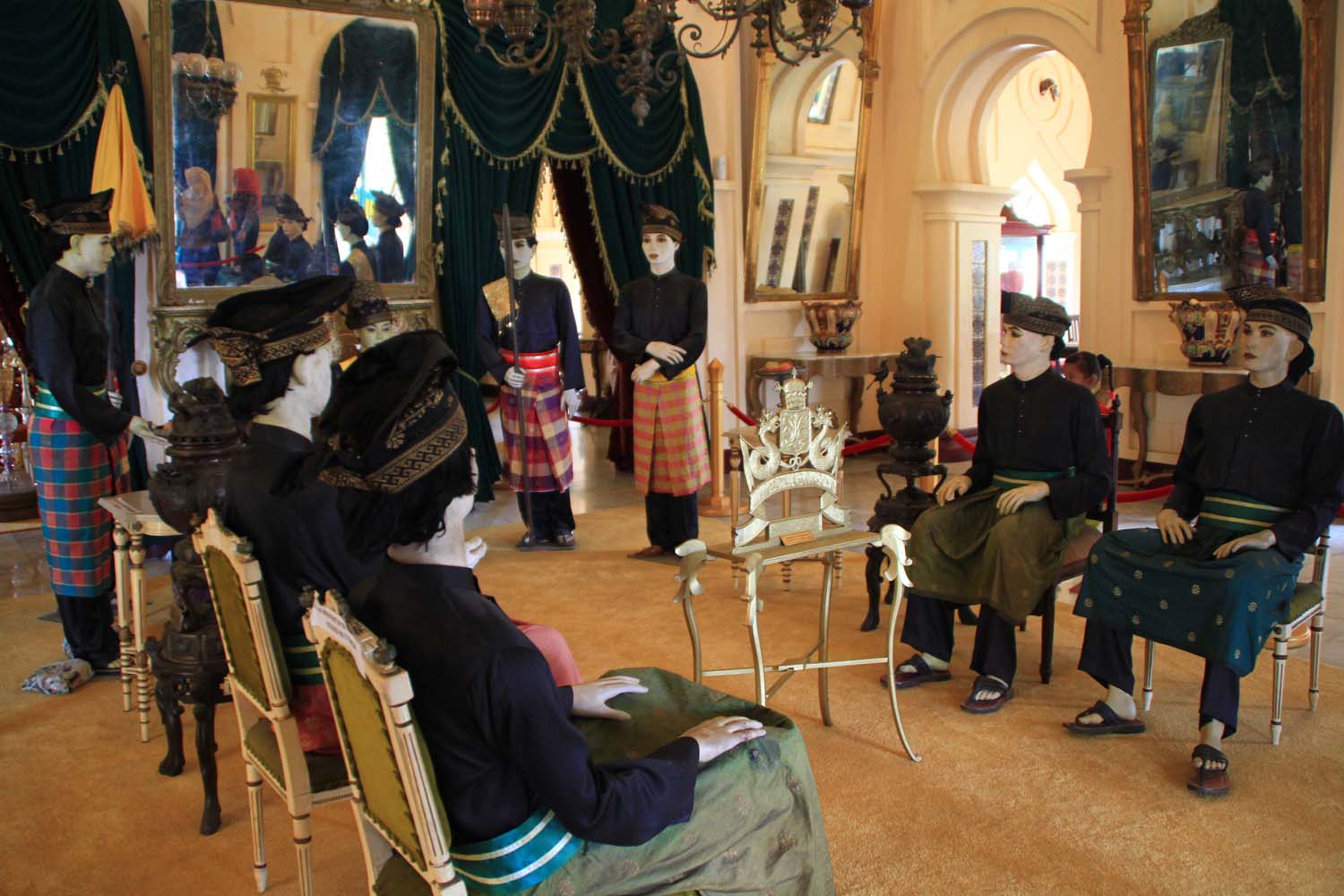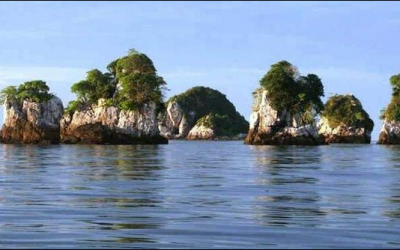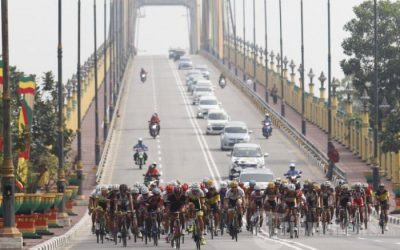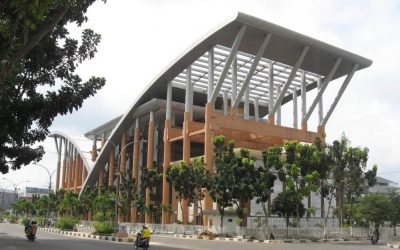Home / Batik Regions – Western Indonesia – Northern Sumatra – Riau / The Sri Indrapura Siak Palace
Cultural Destination
Embrace the spirit of the place!
The Sri Indrapura Siak Palace

The Siak Indrapura Royal Palace (photo: Sinar)

The main hall of Siak Indrapura Royal Palace (photo: Pesona Indonesia)
The Sri Indrapura Siak Palace
Sri Indrapura Siak Kingdom was the largest Islamic Malay kingdom in Riau. The kingdom experienced its glorious period from the 16th to 20th centuries. Founded by Sultan Abdul Jalil Rahmat Syah in 1723 AD, Siak Indrapura palace complex has an area of around 32,000 m² and consists of four palaces. Siak Palace building combines Malay, Middle Eastern, and European architectural styles. Tourists can observe a diverse collection concerning royal objects, ranging from gold-plated throne chairs, royal umbrellas, royal deposit box, duplicate crowns of the king, and even try Riau’s traditional costumes.
Tourist Attractions in Riau
Jemur Island Riau
Jemur Island is a hidden paradise located in
Cycling race tour de siak
Tour De Siak is an annual international bicycle racing activity consisting of
Soeman HS Library
Pekanbaru is the capital of Riau Province and is also famous for educational
Riau
Batik Motifs
Kasih Tak Sampai
‘Kasih Tak Sampai’ is an idiom in the Indonesian language which refers to
Pucuk Rebung Riau
Pucuk Rebung symbolizes heart determination in achieving goals, good luck, and
Tabir Tanjung
Tanjung flower is a type of Cherry tree flower, which is commonly found in
Discover
Indonesian
Batik
Motifs
Tampuk Manggis Sasirangan
The motif illustrates the philosophy of the mangosteen fruit, which is
Kasih Tak Sampai
‘Kasih Tak Sampai’ is an idiom in the Indonesian language which refers to
Pinawetengan
The Pinawetengan Batik pattern was taken from a prehistoric inscription in
Gorga Simeol-Meol
The Gorga Simeol-meol is a pattern of plant tendrils. it is regarded as a symbol of longevity and
Burung Bidadari
Bidadari birds are endemic birds in Halmahera. This motif represents an
Paqbarre Allo
The word “Barre” means round and “Allo” means the sunlight. This motif is interpreted as
Gajah Way Kambas
The motif illustrates the Lampung’s natural reserve, the Way Kambas. it also symbolizes
Desa Na Tolu
The Desa Na Tolu characteristic pattern symbolizes the Batak philosophy of existence and
Leuit Sijimat
This motif reflects the daily activities of the Baduy tribe in Banten. The main ornaments of batik motif consist of:
Ikan tambal
The word “Ikan” refers to fish. The philosophical meaning of Ikan Tambal means is
Pala Salawaku
This motif illustrates the unique weapons of the Maluku region, namely
Durian Pecah
Broken Durian motifs depict the foundation of faith. The second half signifies the mastery of
Bale Lumbu
This motif signifies the welfare of the ancient Sasak society. Bale also symbolizes the
Sero Tangga
The Sero Tangga illustrates an endearing feeling and sacrifices of a person to fulfil
Daun Sirih
This motif illustrates betel leaves that are used by Lombok communities as traditional
Wakatobi
It symbolizes the coastal beauty of the Wakatobi island and the symbol of Patra symbolizes
Enggang Dayak
Local people beliefs that hornbills are an incarnation of the Commander of the Birds. It has supernatural
Kaganga Tanah Rejang
If Batik Besurek combines Arabic calligraphy motifs, then the Kaganga batik takes
Sido Mulyo
Sidomulyo is one of the classical motifs, which is specifically used for the bride’s costume in
Ake Patra
Ake is related to the divinity and the composition of the universe. It is a symbol of
Hiu Taliyasan
Indonesia is also home to the world’s largest fish, the whale shark (Rhincodon typus). Hiu Taliyasan refers to
Sekomandi
Its philosophical meaning is the eternal union which refers to a saying “until death do us part”
Dayak Kamang
Kamang motif is generally found in the Dayak tribe shield because it is believed to
Gamolan
This motif illustrates Gamolan, a bamboo musical instrument of Lampung that is
Mahkota Siger
Siger is the crown of a noblewoman in ancient time. It is a symbol of femininity, strength, and
Teguh Bersatu
This batik motif shows the strength of the people of Kupang. It also represents a sense of
Dayak Taghol
Dayak Taghol has a distinctive style of four curved lines and small dots. This motif represents
Tenun Bima
The motifs are adopted from Bima woven textile. This pattern has received a great
Malinau Cultural Festival
You will witness a unique competition that might not be found other than in
Gonggong Siput
Gonggong (Strombus Turturella) is one type of sea snail found around
Daun Simpor
This motif is inspired by the Simpor plant (Dillenia Suffruticosa) which is a typical
Daun Lada Hitam
The black pepper motif represents the main commodity of Bangka Belitung
Lok Baintan Floating Market
As you can imagine, the most authentic thing is that you can buy things and even
Salakanagara
Salakanagara batik motif illustrates the first kingdom in the Betawi land
Lipaq Sabe
Lipaq Saqbe contains a simple geometric classical motif with various flower decorations. This textile is
Rumah Mamuju
the Batik motif illustrates the house of Mamuju King with the stairs, located on the left of the wooden stage house
Kuda Kupang
Horses symbolize wealth. It contains noble values of virtuous characters that bring
Pohon Hayat (Tree of Life)
The Batik motifs in Lampung are dominated by the acculturation of Buddhist and
Gedhog Kembang Waluh
a combination of Javanese cultural motif of the Majapahit kingdom (XII-XIV century) with
Kerawang Tegak Aceh
The Vertical Upright (Kerawang Tegak) Motif symbolizes a person who has a strong
Insang Ikan
Insang refers to the gills of the fish. This is a typical pattern of Malay ethnic who inhabits
Gurdo Solo
Gurdo or garuda bird is the mount of the Indian god Vishnu. As the Sun Bird,
Besurek Rembulan
This batik illustrates praise for God who created the wonderful universe
Tabir Tanjung
Tanjung flower is a type of Cherry tree flower, which is commonly found in
Besurek Rafflesia
The term “Basurek” refers to a textile that contains letters or inscriptions
Cengkeh
The clove flower motif is the main commodity of the Tolitoli Regency. This motif represents
Pati-Pati Pinehiku
It symbolizes the hierarchy in society and the social status of the Mekongga
Manguni Minahasa
Manguni is identified as the symbol of the Minahasa people. Manguni is known as a
Kaharingan
The Kaharingan or ‘tree of life’ based on the Dayak tribes’ belief system. This tree symbolizes
Raja Ampat
Raja Ampat motif represents the marine life at Raja Ampat archipelago in
Singayaksa
The Singayaksa motif comes from the name of a place where Sultan Hasanuddin used to
Tangerang Herang
Tangerang Herang motif is a symbol of Tangerang city. The Tangerang Herang batik motif consists of
Lontara
The Lontara script itself is a typical ancient script of Bugis and Makassar communities. History records that
Kain Cual
Cual textile tradition has existed since the 17th century. The word “Cual” refers to
Awan Berarak
Awan Berarak is a combination of Dayak motifs and Malay patterns. The word ‘Awan Berarak’ means the
Gumin Tambun
Based on Hindu mythology, this motif symbolizes lucks, abundant wealth, and
Rangkiang
The word “Rangkiang” refers to the rice granary in the Minangkabau language. It symbolizes
Gonggong Beruntun
This motif illustrates that a person should maintain a positive attitude and
Karawo Mahkuta
Mahkuta refers to Gorontalo’s traditional crown. It represents noble characters of
Tanah Liek
The word “Tanah Liek” refers to clay in Minang language. It is also known as
Karawo Pinang
Pinang refers to the Palm areca tree. This motif is considered as the original
Tikar Natuna
The Tikar Natuna motif is adapted from the traditional making of pandanus mats in
Srimanganti
The name of the Srimanganti motif is derived from Palace’s hallway that connects to
Buketan Bali
The Balinese bouquet (Buketan Bali) is a floral arrangement and the name is
Pattimura
Pattimura is the name of an Indonesian hero who fought against colonialism in
Bintik Tujuh
The Bintik Tujuh (Seven Dots) motif has 7 white spots and green color gradation as
Tongkonan
Toraja’s traditional house is called Tongkonan. Tongkonan is a place for
La Galigo
La Galigo is a literary work of the Buginese Epic that has 300 thousand epic lines. It is considered even
Merak Ngeram
The hatching peacock motif has a very deep meaning which refers to the sacrifice and
Parang Rusak
Another meaning behind this motif is an unconquerable spirit, symbolized by
Bomba Mawar
This motif means sacred love for family, kingdom, and God; It also illustrates



